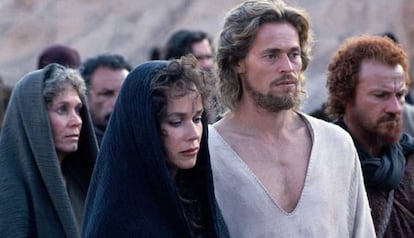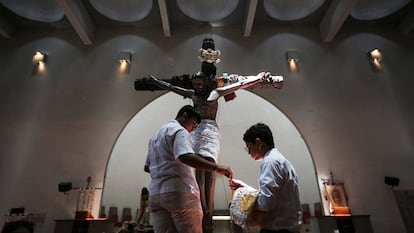
This book will not please convinced Christians, but it will interest those who were believers and one day began to look at religion from a rational perspective. Or lovers of history in general. Catherine Nixey, a Welsh historian born in 1980, has dug into the documents that deal with the life of Jesus Christ, full of versions that are neither accommodating nor similar. Thus she has discovered traces of an arrogant man, feared by his parents, violent at times, who cursed children and impregnated his own mother. Or a charlatan, one of many who wandered the world healing the lame or blind, walking on water, and performing miracles that are repeated in many Mediterranean narratives of the era. The story of the virginity of Mary — in whose vagina an incredulous woman who wanted to verify the miracle after the birth of the son of God burned her hand — takes the cake. Everything has been collected in her new book Heresy, of which Nixey spoke in Madrid with EL PAÍS.
— After all this research, do you think you know Jesus Christ?
— No, does anyone know him? I think the more you read, the less you know. I grew up with this picture of Jesus, who had children around him and bunny rabbits and all of this. But if you read the Bible, you know there are nasty bits, that bit where Jesus says, I am not come to bring peace but a sword. The more you read, the more you realize this is a very complicated historical figure, who it is very hard to get to the bottom of. Partly because there are so many Christian versions: the Jesus who kills people, the Jesus who impregnates his own mother Mary, which actually makes sense in a sense, if you think about it. The Jesus who is angry, the Jesus who is vindictive. It is impossible to say who Jesus was. Christianity was not unique. It did not have one story. It was uniquely successful. And if you look at him as a historian you see a huge and fragmented and interesting picture, which to someone raised as a Catholic is a shock, but an interesting shock.
Nixey was raised in a very religious family. Her father was a friar and her mother had previously been a nun. As such, her first approach was from the faith, until she became a classical historian and worked on the documents of the time — the authorized and unauthorized ones — which have not been adopted by the Catholic Church: the Infancy Gospel of Thomas or the Infancy Gospel of James, for example, from which we have taken traditions such as the mule or the ox in the Christmas representation, but not the brutal abrasion of the hand of Salome when touching the hymen of the Virgin after childbirth.
And she starts from an irrefutable fact: between the death of Christ and the first written accounts, 40 years had passed. “He existed, he was a man, but we have no idea how many of the stories attributed to him are his or those of others. How many of these stories date from his time? How many of them are put on afterwards? The fossil record is very poor. The stories are so similar to ones that appear in other ancient texts, in novels, in magic spells. Forty years is a huge time for oral transmission. That’s a big leap to go with nothing written down. So what happened in the stories in the meantime? They start to look very like all the other stories in the Mediterranean and stories that were written down before them. To ancient critics, he was a charlatan, another magician who performed tricks like so many of the time, perhaps not to get money, but possibly food and certainly respect.”

Jesus’ existence is indisputable, Nixey says, because “he appears in many texts of the period, even in Latin sources such as the mentions of Nero collected by the Roman historian Suetonius. So many of these stories appear again and again and again in not only different versions in Christianity, but in similar different versions outside Christianity. But many also appear in the lives of others,” such as Apollonius, to whom a similar biography is attributed.
The healing of a blind man, for example, is also attributed to Vespasian [9-79 AD, emperor from 69-79 AD] and is linked to a rumor about the arrival of “two men who will come from the east who will rule over the world,” Nixey recounts. “And everybody in Rome thought this was Vespasian because he did rule over the world. But his story is similar to that told in the Gospels and also to that of Asclepius four centuries earlier: another son of a God, another person with healing hands, another person who can make the lame walk and the blind see.” The past, she says, is full of people, not exactly Christian, who performed miracles in the markets, who parted waters, who resurrected the dead… “The same stories recur again and again and again.”
— Why then did Jesus Christ rise above all the others and become so important in our civilization?
— If we look for historical reasons, we have to go to Constantine [emperor from 306 to 337], he made the difference. Roman emperors have always adopted and promoted foreign and Eastern religions, religions came and went at that time. But Constantine adopts Christianity and lives a long time, he remains emperor for 30 years. His sons also have long lives. And one man who could have changed this, Julian, a later pagan emperor [361-363], lived a very short time. If that had changed, if Julian had lived to be 90 and Constantine had been emperor for three years instead of 30, we would not be having this conversation. Everything would have been different.

The nature of Christianity in helping people and contributing to their well-being played a big role in its consolidation. “Definitely. They were proselytizing, so they were trying to convert people, which other religions weren’t really trying to do in this period. And on the other hand, they were providing something that other religions weren’t providing, they helped the needy, widows, orphans… Christianity did this from the beginning and did it well. They offered something that appealed to people at that time.”
The Christian religion was then, says the historian, a kind of health service with a spiritual aura. “And it is logical. Breaking your arm could be life-ending in this world. Life was very hard. We saw this in the pandemic, when everyone prayed more, even I have wanted to pray for my children.”
Jesus Christ, Nixey believes, could never have imagined the impact of his life, which from the beginning sparked criticism from contemporary writers who did not understand what he said because it was “cryptic, contradictory, sometimes violent.” “Even if you just take the Gospels, he’s impossible to know. Ancient critics criticized things he said, and it’s quite refreshing in a way to hear them criticize it, because they criticize it in the way that as a child, sitting in church, you hear these stories and you think, that makes no sense to me.” She refers, for example, to the miracle of the men possessed by demons, whom Jesus freed from evil spirits, which in turn possessed pigs that killed themselves by throwing themselves off a cliff. “This really bothered the ancients. Why is he putting them into the pigs? We think of Jesus as being much more clear-cut than in fact in the Bible he is, and certainly than he was to ancient readers.”

Nixey notes that many of these things have been ignored for almost 2,000 years because theology — and not history or mythology — took charge of the Christian past. There were authors who had tried before to do what she has done now, such as William Hone or Edward Gibbon, but they were “mercilessly attacked.” “If you are a believer, it is difficult to read the other texts and not feel offended or dismissed.” Since the 20th century things have changed and texts such as the Protoevangelium of James, for example, are also used when studying Divinity. “I wouldn’t have wanted to necessarily read all this if I was in full Christian belief.”
This is the text that fixes the donkey and the ox in the Christmas representation, not the Gospels. Pope Benedict’s book Jesus of Nazareth: The Infancy Narratives, in fact, denies their presence in the manger of Bethlehem.
— Do you still put it up, the nativity scene at Christmas?
— Yes, I do! I have three children. We have a little wooden one that comes from Ethiopia I think, with Mary, the mule and the ox and all of that. We do it for them.
— By the way, where does the myth of Mary’s virginity, which is also repeated across different times and cultures, come from?
— Who knows, but it appears again and again in Mediterranean cultures. Why? I don’t know. This is not me as a historian talking. This is just me as a woman. In that period, people liked babies, but they didn’t like women having sex. So it’s like the best of both worlds.
Sign up for our weekly newsletter to get more English-language news coverage from EL PAÍS USA Edition

